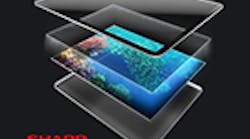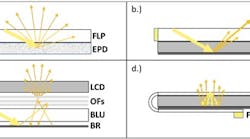As we extend the range of places we can bring our devices and the amount of “things” we want connected, power efficiency becomes a critical consideration. Most of our display electronics evolved from a technology that had an indoor-only mindset, but as devices like fitness trackers, cyclometers and smart monitoring systems for things like doors and garages move our gadgets outdoors; we should think of ways they can work more efficiently in their environment. And that means thinking beyond the backlit LCD. The backlight in an LCD wastes most of the light it produces, and is typically the biggest power-draining component in a device. The good news is you can move away from it with affordable and sourceable Reflective LCD screens that use ambient light to illuminate the display and now incorporate Memory-in-Pixel (MIP) technology, which allows screens to hold a static image indefinitely without drawing power.
IoT makers have avoided displays in the past to save on power figuring they could just beam info straight to a smartphone, but adding a display can make things a lot easier for the end user who may not want to pull out a phone and sign into an app every time they’re looking for a simple answer.
Both Sharp and JDI have recently released a Reflective LCD with MIP aimed at the wearable/IoT market. MIP works like the technology in eReaders that only needs power for images that change on the screen. Reflective LCDs with MIP bring this energy efficiency to displays that are full color and can display HD video. Also important to product engineers and device makers is the fact that it’s not an experimental or nascent technology; it’s LCD, which is easy to adopt and integrate. This means they can work within their supply chains to create big efficiencies that’ll allow their products to do more and go more places.
Reflective displays have grown in popularity over the last few years thanks to their energy efficiency, which in part comes from their ability to use existing ambient light sources. The biggest one being sunlight, and the advantage there is two-fold. Backlit LCD devices aren’t readable in direct sunlight because they’re essentially fighting that light and losing. Reflective displays take the smarter angle of using that sunlight to help illuminate the screen, so there’s big gains in efficiency as well as usability. Cyclists and runners understand the importance of a device’s daylight readability. The same holds true for medical and industrial devices. Any screen that needs to go where its human does will work better and longer in sunlight with a reflective display.
While engineers and product designers have long wanted to move away from a backlit display that’s eating up about 80% of a device’s power, they haven’t had many places to turn. OLED and MicroLED advancements are pressing the boundaries with emissive displays, but even these displays aren’t as energy efficient as Reflective and the materials are either less stable or prohibitively expensive. But they do lose the backlight and address a challenge Reflective display has: how to light the display when there’s no ambient light. This is where a front light system like the one FLEx Lighting makes comes in to play. They’ve created an ultrathin front light that can be laminated over the top of a device and needs as few as one LED to light the display. This light turns on only when needed and creates an incredibly efficient lighting system that works in all lighting conditions. With FLEx Lighting and Reflective LCDs with MIP, you get the energy efficiency and readability in all light conditions that can really push IoT and wearables into new and exciting places.

